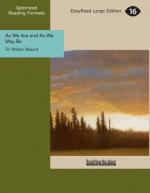A RIVERSIDE PARISH
There are several riverside parishes east of London Bridge, not counting the ancient towns of Deptford and Greenwich, which formerly lay beyond London, and could not be reckoned as suburbs. The history of all these parishes, till the present century, is the same. Once, south-east and west of London, there stretched a broad marsh covered with water at every spring-tide; here and there rose islets overgrown with brambles, the haunt of wild fowl innumerable. In course of time, the city having grown and stretching out long arms along the bank, people began to build a broad and strong river-wall to keep out the floods. This river-wall, which still remains, was gradually extended until it reached the mouth of the river and ran quite round the low coast of Essex. To the marshes succeeded a vast level, low-lying, fertile region affording good pasture, excellent dairy farms, and gardens of fruit and vegetables. The only inhabitants of this district were the farmers and the farmhands. So things continued for a thousand years, while the ships went up the river with wind and tide, and down the river with wind and tide, and were moored below the Bridge, and discharged their cargoes into lighters, which landed them on the quays of London Port, between the Tower and the Bridge. As for the people who did the work of the Port—the loading and the unloading—those whom now we call the stevedores, coalers, dockers, lightermen, and watermen, they lived in the narrow lanes and crowded courts above and about Thames Street.
When the trade of London Port increased, these courts became more crowded; some of them overflowed, and a colony outside the walls was established in St. Katherine’s Precinct beyond the Tower. Next to St. Katherine’s lay the fields called by Stow ‘Wappin in the Wose,’ or Wash, where there were broken places in the wall, and the water poured in so that it was as much a marsh as when there was no dyke at all. Then the Commissioners of Sewers thought it would be a good plan to encourage people to build along the wall, so that they would be personally interested in its preservation. Thus arose the Hamlet of Wapping, which, till far into the eighteenth century, consisted of little more than a single long street, with a few cross lanes, inhabited by sailor-folk. At this time—toward the end of the sixteenth century—began that great and wonderful development of London trade which has continued without any cessation of growth. Gresham began it. He taught the citizens how to unite for the common weal; he gave them a Bourse; he transferred the foreign trade of Antwerp to the Thames. Then the service of the river grew apace; where one lighter had sufficed there were now wanted ten; ’Wappin in the Wose’ became crowded Wapping; the long street stretched farther and farther along the river beyond Shad’s Well; beyond Ratcliff Cross, where the ‘red cliff’ came down




